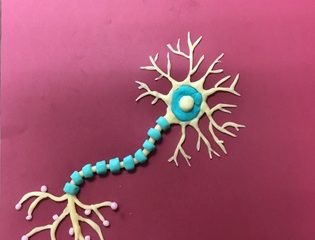Kevin Corcoran and Gregory Quirk have demonstrated an interesting difference in the way learned and innate fears are managed by the brains of rats [1].

Learned fear is typically demonstrated using classically conditioned emotional responses. While a rat barpresses for food, a neutral stimulus such as a tone is presented followed by an electric shock. After several pairings, rats will reduce their barpressing rate during the tone (fear in rats often results in freezing, which of course is incompatible with barpressing for food).
Corcoran and Quirk deactivated the prelimbic cortex of the rats prior to testing using tetrodotoxin (TTX), which blocks sodium channels on the axon membrane, bringing signaling to a halt. TTX is found in some species of pufferfish, and is responsible for the illness or death of some people enjoying fugu, or sushi made from puffers. The rats treated with TTX showed little or no signs of fear during testing with the tone, demonstrating that the prelimbic areas were necessary for the normal expression of fear.
In contrast, when the rats were treated with TTX, they responded with normal freezing in situations that are believed to represent innate fear. If cats were placed in an adjacent enclosure, the rats would freeze. When placed in an open space, which is normally quite frightening to rodents, the treated rats ran for the walls just like untreated rats.
The basic conclusion, therefore, is that the prelimbic areas are not necessary for responding to innately fearful situations, but are quite necessary for the expression of learned fear. These anatomical differences between learned and innate fears might ultimately lead to more effective treatments for learned fears such as phobias and post-traumatic stress disorder.
1. Corcoran, K.A., & Quirk, G.J. (2007). Activity in prelimbic cortex is necessary for the expression of learned, but not innate, fears. Journal of Neuroscience, 27(4), 840-844.



3 Comments
genevieve · May 18, 2007 at 6:17 pm
It’s very interesting this discovery could lead to better treatments of PTSD. I was reading about a current treatment for PTSD being used in which the patient thinks about the traumatic event while rapidly blinking. After a few sessions of this treatment, the traumatic memory seemed to be diffused. I wonder what the neurological connection to this treatment is and if it has anything to do with this discovery.
A new look at fear…. · April 3, 2007 at 9:29 pm
[…] A new look at fearâ�¦. […]
psychology schools » A new look at fear…. · April 4, 2007 at 1:58 am
[…] Managing Editor wrote an interesting post today onHere’s a quick excerptKevin Corcoran and Gregory Quirk have demonstrated an interesting difference in the way learned and innate fears are managed by the brains of rats [1]. Learned fear is typically demonstrated using classically conditioned emotional … […]
Comments are closed.